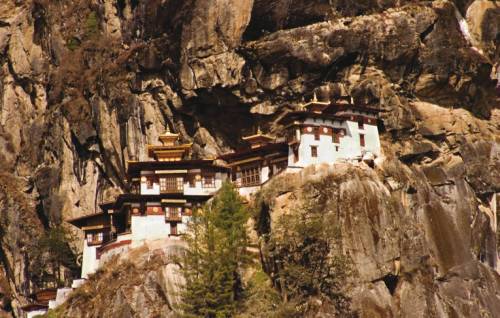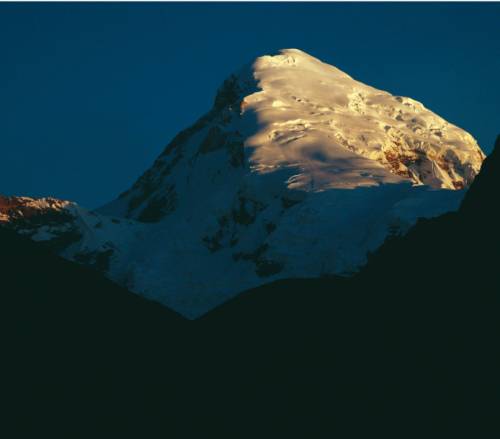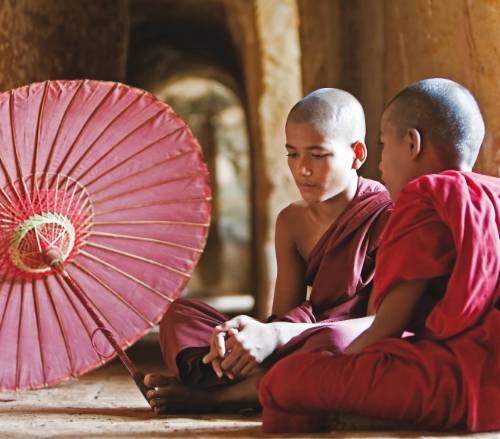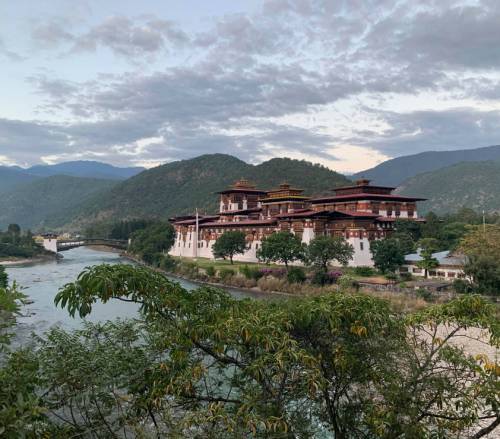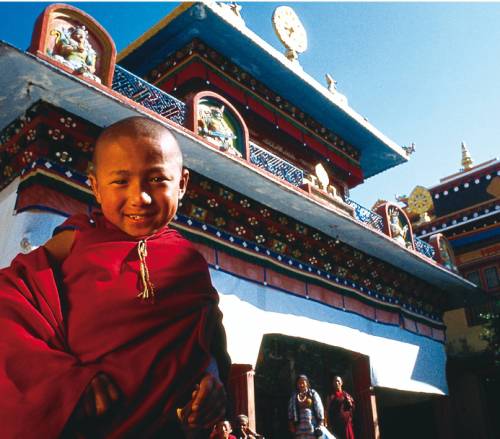Bhutan Thimphu Festival & Trek
Bhutan Thimphu Festival & Trek
$6090
Tour Overview
Embark on an unforgettable journey with the Bhutan Thimphu Festival & Trek tour, where adventure meets cultural immersion. Experience the vibrant Thimphu Festival, Bhutan's largest cultural event, and trek through the breathtaking Bhutan Himalayas from Paro to Thimphu. This fully supported camping trek offers stunning mountain views as you ascend high passes and explore ancient sites like the iconic Taktsang 'Tiger's Nest' Monastery. Enjoy private transportation and quality accommodations in towns, with all group camping equipment provided. Delight in the local culture and traditions, and savor the unique opportunity to witness Bhutan's rich heritage firsthand. With expert bilingual guides and all necessary permits included, this adventure promises a seamless and enriching experience in the heart of Bhutan. ...more ...less
Highlights
Itinerary
Day 1 : Join Paro
Location: Paro, Ta Dzong, Paro Rinpung Dzong
Accommodation Name: lodge
Welcome to Bhutan! On arrival you will be met by your driver and tour guide. This afternoon we ascend a short hill up to the most obvious landmarks in the valley, the Ta Dzong, a circular fortress that once protected this valley from Tibetan invasion. The impressive watchtower commands sweeping views of the valley below. It also houses Bhutan’s National Museum, which, since 1968, has been the home of the country’s most cherished relics. Later we drive down to visit Paro Rinpung Dzong. Bhutan’s dzongs originally served three purposes: they were fortresses, administrative to the most obvious centers for local government, and a residence for the monks and place for their religious activities. In days of yore—during Tibetan invasion or wars between the valleys— dzongs also acted as strongholds, protecting their vale’s inhabitants. Explore inside the Dzong and walk down towards the cantilevered bridge spanning over the Pachhu River where your car will pick you up and head straight to your lodge. Later in the evening, there will be a pre-trip briefing. ...more ...less
Day 2 : Taktsang Monastery hike, walk approx 5-6hrs.
Location: Taktsang Monastery, Kyichu Lhakhang
Accommodation: Hotel
In the morning, we drive up to the base of Taktsang, famously known as the Tiger’s Nest Monastery, perched on a vertical granite cliff 2000 feet above the valley floor of pine, oak and rhododendrons forests. The legend of Taktsang dates from 747 CE, when Guru Rinpoche, in the wrathful form of Guru Dorji Droloe, arrived here on the back of a tiger and subdued the evil spirits of the region. After about one hour of rather steep hiking, you can rest for a while at a small teahouse with wonderful views of the monastery. If you choose to walk another hour, you can get an even closer look from the small chorten directly opposite. The final stretch climbs down—and then back up—700 steps, crossing a gorge over-laced with prayer flags to arrive at the incredible destination. Enjoy the walk and the experience. You will walk back the same route you followed this morning. Later in the evening if time permits, we visit one of the oldest Kyichu temple built in 7th century. This is one temple that truly feels ancient in the Himalayas.
Tiger’s Nest Monastery Hike;
Hike Length: 13.2Km/8.2Miles
Hike Elevation gain and loss approx: 500m/1600ft
Day 3 : Commence trek to Jele Dzong (3,870m/12,770ft), walk approx 4-5hrs.
Location: Paro, Jele Dzong
Accommodation Name: camp
We rise early, and after breakfast, drive from your hotel to Ta-Dzong, passing through the village of Damchena. The drive takes about 1.5 hours. From there, we begin our trek, bypassing a lone Mani wall, and gradually ascend for approximately 2.5 hours through a forest of blue pine and silver birch. Just above the tree line, we reach an alpine glade and the Jele La pass (3,580m), offering fine views of the Paro Valley below.
We will visit Jele Dzong, an impressive fort-cum-monastery with panoramic views. Around the Dzong, many prayer flags hang from commemorative poles, reflecting the ancient Buddhist beliefs that span the ridge tops of Bhutan. The trail continues gradually uphill through the pine forest, and we will set up camp below the Dzong.
Day 4 : Trek to Jangchulakha (3,770m/12,440ft), walk approx. 3-4 hrs.
Location: Paro, Jangchulakha
Accommodation Name: camp
We continue walking along the wooded crest high above the Paro Valley through conifer and rhododendron forest while numerous orchids, ferns and wildflowers line the trail. To the north we will sight the snow capped peak of Chomolhari in the distance. On this stage we also pass through a number of yak herders settlements. Our camp at Jangchulakha which is also used as the grazing grounds by yak herders is in a fine location overlooking the intermediary valley between the Paro and Thimphu Valleys.
Day 5 : Trek to Jigmelangtsho (3600m), walk approx. 5-6 hrs.
Location: Jigmelangtsho
Accommodation Name: camp
Today morning is a strenuous climb up for about 2 hours until we reach the top and continue north along tanned alpine ridge. En route we cross a series of small passes in the vicinity of 4050m with each marked by a stone memorial and an abundance of prayer flags. From the passes there are also fine views of many of the peaks that form the border with Tibet. We keep walking along the ridge rest of the afternoon until Jigmelangtsho comes into view. To reach the lake involves a long and gradual descent taking an hour or so, at first across alpine meadows and then through rhododendron and conifer forest to this wonderful campsite by the side of the lake below, famous for the brown trout.
Day 6 : To Phajoding camp (3650m/12045f), walk approx 6-7hrs.
Location: Pumola, Mt. Gangkar Punsum, Phajoding Goemba, Thimphu
Accommodation Name: camp
We trek through forests of dwarf rhododendron shrubs passing two lakes. After passing the second lake we begin to ascend gradually. From the top of the ridge at Pumola (4,100m/13,530ft), we enjoy the majestic view of Mt.Gangkar Punsum (7520m), the highest mountain in Bhutan. We then descent to a campsite near Phajoding Goemba. It is one of the remotest, beautiful Buddhist monastery and an important pilgrimage site for the Bhutanese people. There are about 150 monks around and you can interact with them and learning from their pursuits of Buddha-hood and enlightenment. At night, you can have a good view of the Thimphu city with lights!
Day 7 : Trek to Thimphu (2,400m/8,000ft) walk approx. 2-3hrs
Location: Thimphu, National Textile Museum
Accommodation: Hotel
Today is the easiest day of trekking. We make our way for three hours downhill through pine forest. Upon reaching Motithang on the outskirt of Thimphu, we will be met by our WEX Bhutan office group to receive you with sumptuous lunch and drinks. Thimphu is Bhutan’s capital and largest city. Home to the government, royal family, and the head offices of international organizations in the country, Thimphu is a mix of Himalayan and Western sensibilities. In the late afternoon, we visit the National Textile Museum, established in 2001, home to a substantial collection of antique textiles and other works including the royal robes on display. There is also a weaving center attached below the museum where women from all over the country has been employed to weave textiles and earn their livelihood. In the evening, stroll and explore the city on foot. Thimphu is one of the few capitals in the world without any traffic lights and you will observe the dancing policemen controlling traffics.
Day 8 : Attend the Thimphu Festival
Location: Tashichho Dzong, Thimphu
Accommodation: Hotel
In the morning we drive to Tashichho Dzong, ‘the fortress of the glorious religion’ which also houses the office of the King. But today you will be joining thousands of locales flocking inside the ceremonial ground to witness and observe the Thimphu Tshechu. No single event captures the prevailing Bhutanese culture better than the Buddhist festival known as tshechus, occasions honoring the significant accomplishments of Guru Rinpoche, the 8th Century figure widely revered across the Himalayas as the Second Buddha. Their focal point is a series of prayers and dances inspired by certain religious themes. Dancers in spectacular costumes perform tightly choreographed moves to a cacophony of drums, horns and cymbals. Constant chanting drifts in waves, a solemn base rising to vivid peaks. What makes such occasions particularly remarkable is the manner in which performance merges with the overall setting. The larger festivals take place in the shadows of imposing fortress-monasteries, attracting large crowds from the surrounding region. For Bhutanese, they represent both the opportunity to concentrate on their religion and as major social occasions. People appear in their finery, eating, drinking and making merry. The overall atmosphere is a rarified blend of devotion, conviviality and slight bawdiness. On show is the holistic, integrated and down-to-earth nature of unaffected popular Himalayan Buddhist culture. Enjoy the experience and be spiritually immersed and be captivated with the lively culture and traditions of the world’s only Vajrayana Buddhist country. This day will also be kept flexible for you to explore on your own around.
Day 9 : Drive to Punakaha (1,300m/4,500ft) via Simtokha Dzong and Dochu La
Location: Thimphu, Simtokha Dzong, Dochu La, Sopsokha, Chimi Lhakhang, Wolakha Nunnery, Punakha
Accommodation: Hotel
In the morning we drive up to see the tallest seated Buddha statue in the world at 51m/169ft height, initiated and built on a prophecy made, facing towards the East, bestowing infinite love and compassion to all sentient beings in the spheres. The statue houses enormous meditational house in the base and two storied chapels on the top floors. You will be fascinated at fine art works crafted by the local artisans. We then drive past Simtokha Dzong, gradually winding up across 10,223-foot Dochu La, which in good weather offers 360-degree vistas across 200 miles of Himalayan peaks including Bhutan’s tallest peak Mt. Gangkar Puensum and some of the highest unclimbed mountains in the world! There are 108 stupas adorning the pass and the scenic spot here offers plenty of opportunities for photography and walks around. We drive down through forests of rhododendrons and magnolias, before the road descends into the warmer lowlands around Sopsokha village just in time for lunch.
Afternoon, enjoy an easy hike to Chimi Lhakhang, or also referred to as the Temple of Fertility. The temple is dedicated to Drukpa Kunley, affectionately called the Divine Madman. He is one of Bhutan’s favorite holy men and the valley is peppered with traces of his influence. Villagers still enthusiastically recount the legends of his exploits. Women who are having trouble conceiving come here to pray and receive the resident lama’s blessings with a wooden phallus. There are about 25 young monks undergoing monastic education. They will be happy to come out and play soccer with you if they are free! Later we drive up to Wolakha Nunnery, mounted over a hilltop with a good view of the surrounding valleys below. The nuns, apart from their daily Buddhist studies and meditation also work on appliqué and thangka painting. The shrine inside is dedicated mainly to the God of Compassion, Chenrizig or in Sanskrit known as Avolokiteshvara. Meet some of the nuns and interact with them.
Chimi Lhakhang Hike;
Hike Length: 2Kms/1.2Miles Hike Time: 1.5 Hours return easy
Elevation gain: 20m/66ft Elevation Loss: 20m/66ft
Day 10 : Visit Punakha Dzong and transfer to Paro (2,300m/7,600ft)
Location: Punakha Dzong, Dochula Pass, Paro
Accommodation: Hotel
In the morning we visit Punakha Dzong, one of the magnificent fortresses in the world. This remarkable fortress was built in 1637 between two rivers and once served as the old capital of Bhutan. It has survived many glacial floods and fire. Every February there is a procession known as the Punakha Serda to commemorate the victory over the Tibetans. The Central Monk Body, taking advantage of it’s warm weather, shifts their residence here every winter and goes back to Thimphu in summers. We spend some time exploring inside and if we see a chance, we may be able to meet a senior monk and Q&A session with him in regard to Buddhism and way of life followed by water purification ceremony to bless you with longevity. This afternoon we drive back again towards Dochula Pass and to Paro valley for the night. Evening time on your own, strolling around this minute town for souvenir and last minute shopping.
Day 11 : Trip concludes in Paro
Location: Paro
This morning drive to Paro and exit through Bhutan Immigration office and bid you farewell today. We hope you had a wonderful time in Bhutan. Tashi Delek & Bon Voyage!
What's Included
-
Airport Transfers
Airport transfers are provided on the first and last day of the tour.
-
Expert Bilingual Guide
An expert bilingual guide will accompany you throughout the tour.
-
Group Medical Kit
A group medical kit is included for safety during the tour.
What's Not Included
-
International Flights
International flights are not included in the tour package.
-
Travel Insurance
Travel insurance is not included and must be arranged separately.
-
Aerated & Alcoholic Drinks
Aerated and alcoholic drinks are not included in the tour package.
-
Tips
Tips for guides and staff are not included.
-
Bottled Water
Bottled water is not included in the tour package.
-
Airport & Departure Taxes
Airport and departure taxes are not included.
What You Carry
In your daypack you will need to carry extra warm clothing (depending on the altitude, location and weather), a rainjacket, water bottle, camera, valuables and personal items such as sunscreen, lip-eze etc. Porters and mules carry all group gear and your trek pack.Grading
* Suggested preparation: 45 minutes of aerobic type exercise, three to five times a week for the three months leading up to your trip. Hill walking with a pack in variable weather conditions or road cycling is also recommended depending upon the activity you plan to undertake.
Mode of Transport
Private transportation is provided throughout the tour, including airport transfers on the first and last day, ensuring a comfortable journey between destinations.Accommodation
Enjoy good quality accommodation in towns and experience a fully supported camping-based trek with all group camping equipment provided.Check out our Q&As
-
What kind of transportation is provided during the tour?
Private transportation is provided throughout the tour, including airport transfers on the first and last day, ensuring a comfortable journey between destinations.
-
What type of accommodation can I expect during the tour?
You will enjoy good quality accommodation in towns and experience a fully supported camping-based trek with all group camping equipment provided.
-
What meals are included in the tour package?
The tour package includes 10 breakfasts, 9 lunches, and 10 dinners.
-
What is the significance of the Thimphu Festival?
The Thimphu Festival, or Tshechu, is a major cultural event in Bhutan that honors the accomplishments of Guru Rinpoche. It features prayers and dances inspired by religious themes, performed in spectacular costumes, and is a significant social occasion for the Bhutanese people. ...more ...less
-
What is the difficulty level of the trek included in the tour?
The trek involves walking for up to 6 or 7 hours a day at a steady pace, with successive days at altitudes not generally exceeding 4,500m. A good level of fitness and health is required.
-
What should I carry in my daypack during the trek?
In your daypack, you should carry extra warm clothing, a rain jacket, a water bottle, a camera, valuables, and personal items such as sunscreen and lip balm. Porters and mules will carry all group gear and your trek pack.
-
Are there any special permits or fees required for the tour?
Yes, all park entrance fees and trekking permits are included, as well as Bhutan Government visa and sustainability fees.
-
What is the significance of the Taktsang Monastery hike?
The Taktsang Monastery, also known as the Tiger's Nest, is perched on a vertical granite cliff and is a significant cultural and religious site in Bhutan. The hike offers stunning views and a chance to explore this historic monastery.
-
Who will be my travelling companions on the tour?
We have offices on three continents which means your travelling companions will be just that – international and wonderfully eclectic. Part of small group travel means that although travellers come from various locations and backgrounds, you will be travelling with like-minded companions who, like you, are keen to share the experience and forge lifelong friendships.
-
What about environmental impact?
We believe that adventure travel revolves around establishing a strong relationship with the people and environments in which we operate. Our responsible travel policies have been carefully developed to ensure that we minimise the impact of our presence and help to protect the regions we visit while contributing positively to the local community.
-
What should I pack?
Your pre-departure documents include a detailed packing list with items that you need to bring. While most of the equipment for daily activities is included in your tour cost, some items like helmets and hiking boots are best brought from home. The pre-departure documents also include information on layering and recommended brands for various items to ensure you are fully prepared for your trip.
-
Do you operate a “single share” option and how does it work?
Yes. World Expeditions does not require single travellers to pay a surcharge for travelling alone on the vast majority of our trips. Our holidays are primarily on a twin share basis, so if you are joining the group as a solo traveller, we will match you with someone of your own gender. The choice is yours however; if you prefer not to share, we do offer single supplements for private occupancy.
-
Are tips included in my trip price?
Tips are not included in the tour cost. Tipping is a personal thing, do not worry about how much, or when, to tip. Tipping guidelines are provided for certain destinations in our pre departure information upon booking, however the best advice will be provided by your tour leader.
-
Am I suited to small-group travel?
We recognise that many of our travellers have not been on a ‘group trip’ before. Yet what our departures provide is both structure and flexibility, allowing you plenty of freedom within the framework of the itinerary. You’ll find that with our maximum group size at 16, you’ll travel in a minimal impact style with a great group of like-minded travellers.
-
Can you advise which vaccinations are recommended?
While our pre-departure kit provides information on vaccinations, we suggest that you consult your doctor, local government inoculation centre or a travel medical specialist in order to get the most current advice regarding vaccination requirements.
Reviews from travellers on this tour
1 Select your preferred date
Friday - Monday
Sep 26, 2025 - Oct 06, 2025Tuesday - Friday
Sep 15, 2026 - Sep 25, 2026Book with Confidence
-
Transfer as credit for future tours
World Expeditions allows you to transfer existing payments to a future tour to avoid cancellation fees if you can't travel and inform world expeditions, 70 days before departure.
-
Low Deposit
World Expeditions requires a minimum deposit of 400 GBP per person or the full booking value, whichever is less, with the final balance not due until 70 days before departure.
-
Cancellation Policy
We don't charge a cancellation fee, here is a summary of world expeditions charges.
Up to 70 days before tour starts: Forfeit 100% of deposit.
At 69 days before tour starts: Forfeit 50% of booking price.
At 35 days before tour starts: Forfeit 100% of booking price.
Bhutan Thimphu Festival & Trek
11 Days Starting and ending in Paro, Bhutan
Visiting: Paro, Ta Dzong, Paro Rinpung Dzong, Taktsang Monastery, Kyichu Lhakhang, Jele Dzong, Jangchulakha, Jigmelangtsho, Pumola, Mt. Gangkar Punsum, Phajoding Goemba, Thimphu, National Textile Museum, Tashichho Dzong, Thimphu, Simtokha Dzong, Dochu La, Sopsokha, Chimi Lhakhang, Wolakha Nunnery, Punakha, Punakha Dzong, Dochula Pass ...more ...less
Tour operator:
Tour code:
BFT
Guide Type:
Fully Guided
Group size:
3 - 16
